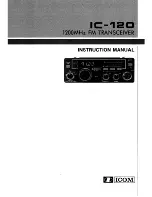
3-13
WRT-808A (U)
3-2-12. Battery Alarm Signal Check
Equipment and Tools
DC power supply
DC output Voltage:
+
3.0
±
0.1 V dc
DC ammeter
Frequency counter
Spectrum analyzer
Modulation analyzer
MM-SMA (J) connector (Part No. J-6402-480-A)
SMA-BNC (J) connector (Part No. J-6402-490-A)
Switch and Control Setting
The following setting is to be perform with the channel se-
lect switches (S504 and S505).
Transmitting Channel setting:
U64 model:
65-01 channel (776.125 MHz)
U66 model:
67-01 channel (788.125 MHz)
U68 model:
69-01 channel (800.125 MHz)
RF power output switch (S401): 50 mW
Input LEVEL control (RV101): “
_
60” (0 dB attenuation)
Turn the RV101 clockwise
fully.
1. Frequency deviation check
Connections
(For connecting the DC power supply, refer to the “Preparations”
on page 3-2.)
Procedure
n
Perform the checking with the MIC input connector (CN101)
short-circuited.
(1) Set the spectrum analyzer as follow:
CENTER FREQUENCY (fc):
U64 model: 776.125 MHz
U66 model: 788.125 MHz
U68 model: 800.125 MHz
REFERENCE LEVEL:
20 dBm
FREQUENCY SPAN:
200 kHz (20 kHz/DIV)
RBW (resolution band width): 3 kHz
VBW (video band width):
1 kHz
ATT:
20 dB
(2) Decrease gradually the DC output voltage of the DC
regulated power supply and confirm that the battery
alarm signal turns on at 2.0
±
0.1 V.
(3) While the TP201 is short-circuited to the frame (GND)
with a tweezers etc (TONE signal ; OFF), check that
level difference between carrier frequency (center fre-
quency level) on spectrum analyzer and tone signal is
with in 29
±
1 dB.
fc
32.782 kHz
V : 10 dB/div
H : 20kHz/div
29
±
1 dB
20 dBm
TP201
Tweezers
Bridge the TP201
and frame (GND)
with tweezers.
10
50
TP201
Frame
Frame
2
1
Short-circuit
XLR 3Pin (male)
- wiring side -
3
MM-SMA (J) connector
with SMA-BNC (J) connector
CN402
Spectrum
analyzer
















































